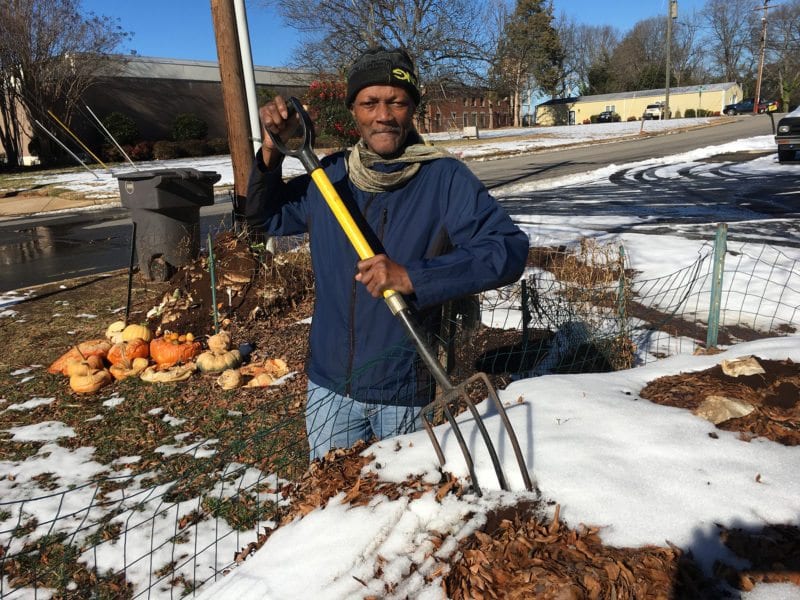GREEN AND GROWING
Erosion Control

Potts Street resident, Lee Green, maintains piles of mulch, compost, and hay to nourish the soil at the Community Garden. (Bill Giduz photo)
To control soil erosion, a gardener must think like an engineer. Erosion begins with rain falling from miles above the earth, hitting bare earth, and detaching soil particles. The detached soil particles are lifted and transported by the run-off. When the water dissipates, the transported soil is deposited. Gardeners faced with an eroding slope must interfere with one of more of these mechanical actions to control the erosion.
The tried and true method for most garden applications is to cover the ground with mulch or plant materials so that rain drops do not directly hit the soil, and run-off does not develop enough velocity to transport the soil. The best mulches do not themselves detach and float away in the rain. Pine straw, shredded hardwood and shredded pine barks all have interlocking fibers that help to hold them in place and capture transported soil. Pine bark nuggets and small stones do not.
Mulch, by itself, is seldom enough to control erosion that has already begun to create a gully. To meet this challenge, the gardener must install plants whose leaves will deflect rain and whose roots will hold soil to inhibit detachment. The plant families that best fit these requirements are native, non-turf grasses, sedges, and complimentary wildflowers. All have deep, tough, fibrous root systems that will hold soil. Among the best candidates for erosion control in the garden are Little Bluestem, switchgrass, Muhly grasses, Suwannee blue-eyed grass, and Indian grass. Among the sedges are Appalachian sedge and Oak sedge.
One also reads recommendations to plant traditional groundcovers, such as common periwinkle, bugleweed, English ivy, and wintercreeper. I couldn’t disagree more. First, these vines lack the fibrous root systems of native grasses and wildflowers. These plants also are all highly invasive, posing a threat not only to our native plant environment but also to other areas of the cultivated garden where they are not wanted. Planting invasive vines for erosion control is similar to the mistake made by the United States Department of Agriculture in the 1932, when it encouraged farmers to plant kudzu.
Shrubs and trees can compliment a planting of grasses and sedges, but not every such plant will control erosion. Any shrub must be like the recommended grasses—it must have a strong, fibrous root system to hold itself and the soil in place. It must also have a leaf density sufficient to block the force of rain but without depriving the underlying grasses of needed sun.
Tree roots combined with tree canopies will usually out-compete grasses and kill them. At the same time, the tree roots will not be sufficient in themselves to hold the soil in place. To make matters worse, should the tree fall, it will badly disrupt the surface of the slope, leading to more erosion. For all these reasons, the only trees that should bee planted on a slope are small, open canopied ornamental trees in scale with the grasses, forbs, and shrubs that grow beneath them.
The next line of defense is landscape modification. A dry streambed that meanders across the face of the slope will collect and transport run-off water before the water can transport soil. The stream bed will provide additional opportunities for creative planting. Keep the slope of the stream below 5 percent and make sure it is deep enough to hold the water within its banks, rather than losing it on the downhill side. The water carried by the streambed, ultimately, must go somewhere, and a rain garden makes an excellent destination. I will write about this landscape device in a future column.
Tom Watson
Tom Watson is a Volunteer Extension Master Gardener in Mecklenburg County. He has also received a Certificate in Native Plants from UNC-C and a Certificate in Horticulture Technology--Residential Landscape Design from CPCC. He and his wife, Sue Bartlett, own The Cedars Davidson Bed & Breakfast.


